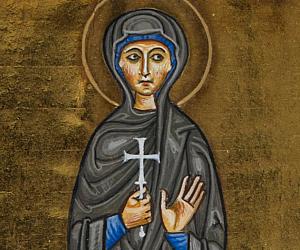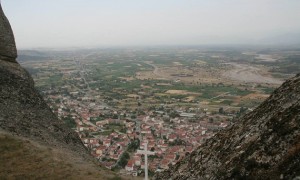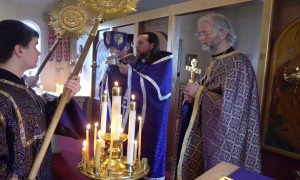Holy Tradition vs. Sola Scriptura: The Witness of the Liturgy (2)
4 August 2017 Post-Apostolic Development
Again, it is not the purpose of this essay to provide a detailed narrative of the development of the Orthodox Christian liturgy. Such a task would be, of itself, a very lengthy one. Instead, we shall briefly sketch the development of the liturgy up until the fourth century, highlighting certain common themes constantly present during this development. We will do so by looking at a few representative early Church documents:
• The Teaching of the Lord to the Gentiles through the Twelve Apostles, commonly known as The Didache. There are many theories about the origin and purpose of this early work. Paragraphs 9 and 10 are relevant to our discussion. Their primitive character is attested by their lack of the Words of Institution (Take , eat. . . . Take, drink.) and by the wording of its Thanksgiving prayer, which is very close to that of Jewish forms of grace at table.
• The Letter of St. Clement of Rome to the Corinthians. St. Clement deals with issues of order and procedure (cf. paragraphs 40 and 41). He already models the Eucharist on the pattern of Temple worship.
• The Letter of St. Ignatius of Antioch to the Smyrnaeans. St. Ignatius’s reference to the Eucharist as the body,[6] or flesh,[7] of our Savior may indicate that the Words of Institution, as they are known in the Gospels, were already in use (cf. paragraphs 7 and 8).
• The Apostolic Tradition of Hyppolitus, a third-century document, is the most important source of information we possess on the liturgy of the pre-Nicene church.[8] It contains an undeveloped form of the Eucharistic prayer and reflects the liturgical tradition of the local Church of Rome. It makes direct use of the Words of Institution.
• The Mystagogical Catecheses of St. Cyril of Jerusalem. The Catecheses were instructional lectures, first delivered orally but written down in shorthand. The form we have today is that of a transcript made by someone in the audience, and it is not St. Cyril’s original manuscript.[9] These lectures were delivered to Christians in various states of instruction. It contains a full description of the Liturgy in Jerusalem in the fourth century.
The Form of the Early Liturgy
Several other liturgical traditions existed at the time; for example, that of the Churches at Jerusalem, Alexandria, and Edessa. Though the petitions and emphases of these early liturgies varied somewhat, they all shared in common a central core, or form. This form, or shape, is distinguished by a four-step scheme in the Eucharistic action:
(1) The Offertory. Bread and wine are taken and placed on the table together;
(2) The Thanksgiving or Eucharistic Prayer. The president, or celebrant, gives thanks to God over the bread and wine together;
(3) The Fraction. The Bread is broken;
(4) Communion. The Bread and Wine are distributed together.[10]
This four-step action is somewhat different from the scheme we find in the New Testament. There we find a seven-step scheme within the inauguration narrative. There we read that Our Lord:
(1) took bread;
(2) gave thanks over it;
(3) broke it;
(4) and distributed it, saying certain words.
Later, He:
(5) took a cup;
(6) gave thanks over it;
(7) and handed it to His disciples, saying certain words.[11]
The central question facing us is: why? Why is there a discrepancy between the actions of Jesus, as narrated in the Synoptic Gospels, and in St. Paul’s letter to the Corinthians and the Liturgical actions of the early Church? The answers lies, paradoxically, at the origin of the Eucharist itself: the Last Supper.
The Last Supper, the Eucharist, and the Jewish Milieu.
The obvious answer to our question is this: The last supper of our Lord with His disciples is the source of the Liturgical Eucharist, but not the model for its performance.[12] Let us refocus our answer: The actions which transpired during the Last Supper and preserved in the canonical Gospels and in the First Letter of St. Paul to the Corinthians are not the model for the performance of the historical Eucharist. As it will be demonstrated, the New Testament narratives influenced the Liturgy at a relatively late period of its development. The traditions from which the New Testament and the Eucharist developed had a common origin. They progressively influenced each other’s growth and canonicity up until the doctrinal settlement of the fourth century. To arrive at this conclusion we examine the source of the Liturgical Eucharist: the Last Supper.
The Jewish Chabûrah Meal
The Last Supper should be seen within the historical context from which both the New Testament narratives and the Liturgical Eucharist evolved. To do that, the following hypothesis is in order: According to St. John’s Gospel, our Lord instituted the Eucharist at a supper with His disciples, which was probably not the Passover supper of that year but the evening meal twenty-four hours before the actual Passover.[13] The Last Supper, then, belonged to another formal category of meals for which there were also exacting preparations and rituals known as chabûrah (from Heb. chaber=friend).[14]
Dix uses quite a bit of ink to support his claim that the Last Supper was a chabûrah meal. We will limit ourselves to reading one of Dix’s conclusions that is relevant to our inquiry. Reconstructing the primitive Eucharist, Dix finds the origin of the four-action shape of the Liturgy in this meal:
(1) The Offertory. Each communicant brings for himself or herself a little bread and wine, and also frequently, other small offerings in kind of different sorts, oil, cheese. . . . This is simply a survival of the custom or providing the chabûrah supper out of the contributions in kind by its members, though in the case of the bread and wine, another meaning was given to the offering by the church before the end of the first century.
(2) The prayer. The long Thanksgiving at the end of the meal was always regarded as and called in Jewish practice ‘the Blessing’ for all that had preceded it. It was also specifically the blessing of the ‘cup of blessing’ itself (which did not receive the ordinary wine blessing). Accordingly, it now becomes “the Blessing” or “the Prayer” of the Eucharist, said over the bread and wine together. . . . That this was so can be seen from its special name. “The Eucharist” (-ic Prayer), he eucharistia, “The Thanksgiving,” which is simply the direct translation into Greek of its ordinary rabbinic name, berakah.
(3) The fraction. The bread was originally—at the chabûrah meal and the Last Supper—broken simply for distribution and not for symbolic purposes immediately after it had been blessed. So, in the liturgical “four-action” shape of the rite, it is broken at once after the blessing (by the eucharistia, along with the wine) for Communion, which follows immediately.
(4) The Communion. It appears to have been the universal tradition in the pre-Nicene Church that all should receive Communion standing. This was the posture in which the cup of blessing was received at the chabûrah meal, though the broken bread was received sitting or reclining at table. Presumably the change in posture for receiving the bread was made when the meal was separated from the Eucharist. The Jews stood for the recitation of the berakah and to receive the cup of blessing, and this affected the bread, too, when its distribution came to be placed between the end of the berakah and the handing of the cup.[15]
The Liturgy as Oral Tradition
Thus far, we have seen how the four-action shape of the Liturgy differs in form with the series of actions narrated and preserved in the Institution narratives contained in the New Testament. We have also seen how this shape had as its origins the Jewish ritual meal called chabûrah. Once again, the question we now face is: why? Why has a nonscriptural, Jewish religious meal provided the framework for Christian worship for over 1500 years? Before we attempt to answer this question, we will backtrack a little to the period preceding the writing of the canonical Gospels.
We should agree, as a matter of principle, to the following tenets:
• Jesus wrote no book; He taught by word of mouth and personal example.
• Some of his followers taught in writing as well as orally.
• Often, indeed, their writing was a second-best substitute for the spoken word.[16]
There is nothing unlikely about this fact. In an era when reading and writing were skills mastered by a relative few, oral tradition was the necessary vehicle to preserve and hand down practical and religious knowledge from father to son, and from teacher to student. Nor were the Jews unique in this respect, either at this time, or in that region of the world. Most, if not all, of the cultures in the world at that time were, fundamentally, oral cultures.
The scholarly consensus is that the Synoptic Gospels were written near or before 70 A.D. This is also true of the Pauline corpus. It would take some years before they would become authoritative and, as a result of this, canonical. Yet, even before St. Paul put in writing “that which [he had] received” (cf. 1 Cor. 11:23-24), the shape of the Liturgy already existed.
For now, we will refer to this tradition as the liturgical tradition. The evidence also warrants the following conclusion: this liturgical tradition existed independently from, yet shared a common origin with, the oral tradition from which the New Testament evolved. That it was held in the highest esteem is proven by the fact that the four-action shape of the Liturgy was not affected by the Gospels or First Corinthians. Apparently, the Church had very grave reasons to hold to the shape even if it meant ignoring the New Testament in this one point. Let us also remember that the first written hint of the New Testament having an effect on the prayers of the Liturgy is found in the letters of St. Ignatius.[17] By that time, the Church had been celebrating the chabûrah of the Lord for about 80 years.
Again, in a culture such as the Jewish one, where oral tradition was held in the highest esteem, the staying power of the shape is not unexpected. What is unexpected and relevant to the Sola Scriptura controversy is that it had such an authority, such a binding power over and beyond the New Testament through subsequent generations of Christians, most of them not even Jewish.
The Liturgy As Foundational, Binding Tradition
Once again, Dix seems to say it best:
“It is important for the understanding of the whole future history of the Liturgy to grasp the fact that the Eucharistic worship from the outset was not based on Scripture at all, Old or New Testament, but solely on tradition. The authority for its celebration was the historical tradition that it had been instituted by Jesus, cited incidentally by St. Paul in 1 Cor. 11, and attested in the second Christian generation by the written Gospels.”[18]
Thus, the Liturgy is:
• An oral tradition, originating with Jesus Himself;
• Parallel to the traditions that originated the New Testament;
• Handed down, as it were, in the very act of its celebration;
• Handed down from one generation of Christians to the next by those who participate in it in different capacities.
We can then speak of the Liturgical tradition as a foundational tradition, as one of the traditions that established the Church as a chabûrah of the Lord, as a community of Thanksgiving, and as something upon which the subsequent doctrinal and disciplinary structure of the Church was to be built.
For Christians, a foundational tradition is a binding tradition. The concept of binding was one that the Apostles and the first Jewish-Christian generation were familiar with. The celebrated verses in Matthew 16, for example, use the terms binding and loosing, no doubt, because its intended recipients, converts from Judaism, were familiar with the terminology. To bind is, in fact, a legal term often used by the rabbis to define who belongs to the Elect (i.e. Israel) and who does not. What is bound is the believer’s conscience, who must respond in love and obedience to the authority of the God who reveals Himself.
The Liturgical tradition, being foundational and binding, is then considered holy. It is holy on account of its founder, Our Lord Jesus Christ, Himself. The very fact that the liturgical tradition is foundational makes it holy.
It is holy on account of its purpose, which is to define the identity of the Christian Church against the unbelieving world, to set the Church apart (i.e., to sanctify her, to make her holy) from the world and for God as His chabûrah.[19]
The liturgical tradition is also holy on account of its end, the glorification of God in the Person of His Anointed Son, whose saving deeds are made present anew within the worshipping community. It is also within this community, joined in holy Liturgy, where the hope of His coming again in glory is preserved.
Though we can now speak of the Liturgy as a holy tradition, we cannot still refer to it as Holy Tradition, in capital letters, as a proper name. We will refrain from doing so until we define the Liturgy’s pedagogical character, its relationship with the New Testament, and its ultimate scope. Once again, we return to the period before the writing of the New Testament.
6. Staniforth et al, Early Christian Writings, p. 103.
7. Jurgens, William A., The Faith of the Early Fathers, vol. 1, p. 25.
8. Dix, p.157.
9. Jurgens, vol. 1, p.347.
10. Dix, p.48.
11. Ibid.
12. Ibid., p.50.
13. Ibid. Dix quotes another work by Dr. W.O.E. Oesterly, Jewish Background of the Christian Liturgy, as his authority to assert the Johannine priority upon the development of the Liturgy. Dix is also aware of the (for him) recent challenges to that Johannine priority. The Reverend R. T. Beckwith, in his article for The Study of Liturgy (“The Jewish Background to Christian Worship,” p. 48) takes the opposite view: Jesus and His disciples took part of a Passover meal as the Synoptic Gospels seem to tell us. Both authors agree that the Jewish prayers contained in the Talmud (Jer. Berakoth 7.2; Bab. Berakoth 48b) form the model of the Christian Eucharistic prayer.
The Orthodox Church has traditionally held the Johannine priority. It also sees confirmation of the fact that the Last Supper was not a Passover meal because of the use in all the New Testament sources of the word artoz (leavened bread) to designate the bread that Our Lord took and broke, and not axumoz (unleavened bread), which is essential in the Jewish Passover rite.
14. This is not to deny the Paschal character of the Lord’s Last Supper. After all, the New Testament belabors the connection between the Lord’s death as “the Lamb of God who takes away the sins of the world” and the institution of the New Covenant with the Paschal Lamb and the institution of the Old. Our purpose is to categorize the type of meal that the Last Supper was, not to deny its obvious antitypical significance.
15. Dix, 78. I disagree with Dix when he states that the breaking of the bread had no symbolic meaning in the Last Supper, just as it does not during the chabûrah meal. The Lord was quite free to invest the elements of the ritual with new meaning, and He, in fact, did so with the main purpose of the meal.
16. F.F. Bruce. The Canon of Scripture, p. 118. Bruce is known worldwide as the dean of evangelical biblical scholars (from the inside cover of his book).
17. It is also significant that these letters also offer the first written testimony of the knowledge of, and the extent of, the fledgling New Testament in the post-Apostolic Church.
18. Dix, 2. Emphasis mine.
19. “Set apart” is the primitive meaning of the verb sanctify or make holy.












